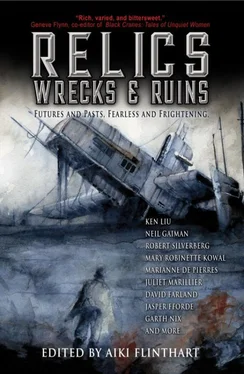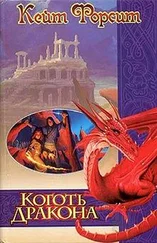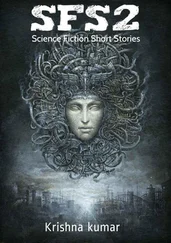He conjures up for us a picture of his industrious ancestors toiling cheerfully and unremittingly in their poisonous environment. The Japanese, he insists, were able to maintain and even increase their gross national product at a time when other nationalities had already begun to lose ground in the global economic struggle because of diminished population owing to unfavorable ecological factors. And so on and so on.
After a time we grow bored with Edward’s incessant boasting. “Stop boasting,” Oliver tells him, “or we will expose you to the atmosphere.” We have much dreary work to do here.
Paul and I guide the huge trenching machines; Oliver and Ronald follow, planting seeds. Almost immediately, strange angular shrubs spring up. They have shiny bluish leaves and long crooked branches. One of them seized Elaine by the throat yesterday and might have hurt her seriously had Bruce not uprooted it. We were not upset. This is merely one phase in the long, slow process of repair. There will be many such incidents. Someday, cherry trees will blossom in this place.
#
This is the poem the river ate:
Destruction
I. Nouns. Destruction, desolation, wreck, wreckage, ruin, ruination, rack and ruin, smash, smashup, demolition, demolishment, ravagement, havoc, ravage, dilapidation, decimation, blight, breakdown, consumption, dissolution, obliteration, overthrow, spoilage; mutilation, disintegration, undoing, pulverization; sabotage, vandalism; annulment, damnation, extinguishment, extinction; invalidation, nullification, shatterment, shipwreck; annihilation, disannulment, discreation, extermination, extirpation, obliteration, perdition, subversion.
II. Verbs. Destroy, wreck, ruin, ruinate, smash, demolish, raze, ravage, gut, dilapidate, decimate, blast, blight, break down, consume, dissolve, overthrow; mutilate, disintegrate, unmake, pulverize; sabotage, vandalize, annul, blast, blight, damn, dash, extinguish, invalidate, nullify, quell, quench, scuttle, shatter, shipwreck, torpedo, smash, spoil, undo, void; annihilate, devour, disannul, discreate, exterminate, obliterate, extirpate, subvert; corrode, erode, sap, undermine, waste, waste away, whittle away (or down); eat away, canker, gnaw; wear away, abrade, batter, excoriate, rust.
III. Adjectives. Destructive, ruinous, vandalistic, baneful, cutthroat, fell, lethiferous, pernicious, slaughterous, predatory, sinistrous, nihilistic; corrosive, erosive, cankerous, caustic, abrasive.
“I validate,” says Ethel.
“I unravage,” says Oliver.
“I integrate,” says Paul.
“I devandalize,” says Elaine.
“I unshatter,” says Bruce.
“I unscuttle,” says Edward.
“I discorrode,” says Ronald.
“I undesolate,” says Edith.
“I create,” say I.
We reconstitute. We renew. We repair. We reclaim. We refurbish. We restore. We renovate. We rebuild. We reproduce. We redeem. We reintegrate. We replace. We reconstruct. We retrieve. We revivify. We resurrect. We fix, overhaul, mend, put in repair, retouch, tinker, cobble, patch, darn, staunch, caulk, splice. We celebrate our successes by energetic and lusty singing. Some of us copulate.
#
Here is an outstanding example of the dark humour of the ancients. At a place called Richland, Washington, there was an installation that manufactured plutonium for use in nuclear weapons. This was done in the name of “national security,” that is, to enhance and strengthen the safety of the United States of America and render its inhabitants carefree and hopeful. In a relatively short span of time these activities produced approximately fifty-five million gallons of concentrated radioactive waste. This material was so intensely hot that it would boil spontaneously for decades, and would retain a virulently toxic character for many thousands of years.
The presence of so much dangerous waste posed a severe environmental threat to a large area of the United States. How, then, to dispose of this waste? An appropriately comic solution was devised. The plutonium installation was situated in a seismically unstable area located along the earthquake belt that rings the Pacific Ocean.
A storage site was chosen nearby, directly above a fault line that had produced a violent earthquake half a century earlier. Here 140 steel-and-concrete tanks were constructed just below the surface of the ground and some 240 feet above the water table of the Columbia River, from which a densely populated region derived its water supply.
Into these tanks the boiling radioactive wastes were poured: a magnificent gift to future generations. Within a few years the true subtlety of the jest became apparent when the first small leaks were detected in the tanks.
Some observers predicted that no more than ten to twenty years would pass before the great heat caused the seams of the tanks to burst, releasing radioactive gases into the atmosphere or permitting radioactive fluids to escape into the river. The designers of the tanks maintained, though, that they were sturdy enough to last at least a century. It will be noted that this was something less than one percent of the known half-life of the materials placed in the tanks.
Because of discontinuities in the records, we are unable to determine which estimate was more nearly correct. It should be possible for our decontamination squads to enter the affected regions in eight hundred to thirteen hundred years. This episode arouses tremendous admiration in me. How much gusto, how much robust wit, those old ones must have had!
#
We are granted a holiday so we may go to the mountains of Uruguay to visit the site of one of the last human settlements, perhaps the very last. It was discovered by a reclamation team several hundred years ago and has been set aside, in its original state, as a museum for the tourists who one day will wish to view the mother-world.
One enters through a lengthy tunnel of glossy pink brick. A series of airlocks prevents the outside air from penetrating. The village itself, nestling between two craggy spires, is shielded by a clear shining dome. Automatic controls maintain its temperature at a constant mild level. There were a thousand inhabitants. We can view them in the spacious plazas, in the taverns, and in places of recreation.
Family groups remain together, often with their pets. A few carry umbrellas. Everyone is in an unusually fine state of preservation. Many of them are smiling.
It is not yet known why these people perished. Some died in the act of speaking, and scholars have devoted much effort, so far without success, to the task of determining and translating the last words still frozen on their lips.
We are not allowed to touch anyone, but we may enter their homes and inspect their possessions and toilet furnishings. I am moved almost to tears, as are several of the others.
“Perhaps these are our very ancestors,” Ronald exclaims.
But Bruce declares scornfully, “You say ridiculous things. Our ancestors must have escaped from here long before the time these people lived.”
Just outside the settlement I find a tiny glistening bone, possibly the shinbone of a child, possibly part of a dog’s tail. “May I keep it?” I ask our leader. But he compels me to donate it to the museum.
#
The archives yield much that is fascinating. For example, this fine example of ironic distance in ecological management. In the ocean off a place named California were tremendous forests of a giant seaweed called kelp, housing a vast and intricate community of maritime creatures. Sea urchins lived on the ocean floor, one hundred feet down, amid the holdfasts that anchored the kelp. Furry aquatic mammals known as sea otters fed on the urchins.
Читать дальше











